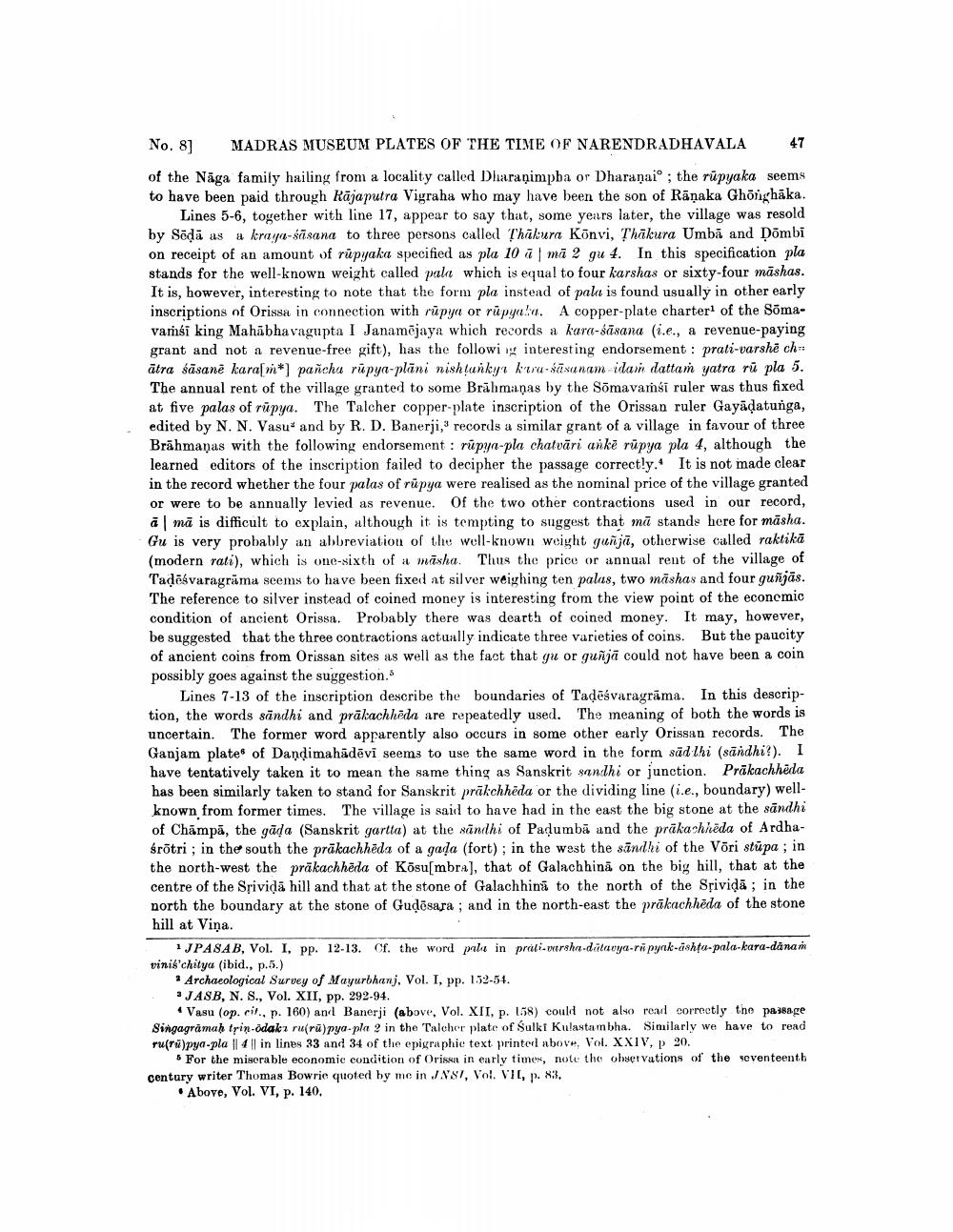________________
No. 8]
MADRAS MUSEUM PLATES OF THE TIME OF NARENDRADHAVALA
47
of the Nāga family hailing from a locality called Dharaṇimpba or Dharanaio; the rūpyaka seems to have been paid through Kāja putra Vigraha who may have been the son of Räņaka Ghonghāka.
Lines 5-6, together with line 17, appear to say that, some years later, the village was resold by Södā as a kraya-sisana to three persons called [hakura Kõnvi, Thakura Umbā and Dombi on receipt of an amount of rūpyaka specified as pla 10 ū mā 2 gu 4. In this specification pla stands for the well-known weight called part which is equal to four karshas or sixty-four māshas. It is, however, interesting to note that the form pla instead of pala is found usually in other early inscriptions of Orissa in connection with rūpya or rūpyala. A copper-plate charter of the Somavamsi king Mahābhavagupta I Janamējaya which records a kara-säsana (i.e., a revenue-paying grant and not a revenue-free gift), has the following interesting endorsement : prati-varshe ch -- ātra sāsanë karalw*) pañchu rūpya-plāni nishlunkyu kuru-sasunam idain dattam yatra rū pla 5. The annual rent of the village granted to some Brāhmaṇas by the Sõmavamsi ruler was thus fixed at five palas of rūpya. The Talcher copper-plate inscription of the Orissan ruler Gayāṇatunga, edited by N. N. Vasu" and by R. D. Banerji, records a similar grant of a village in favour of three Brāhmaṇas with the following endorsement : rūpya-pla chatvāri anke rüpya pla 4, although the learned editors of the inscription failed to decipher the passage correctly. It is not made clear in the record whether the four palas of rūpya were realised as the nominal price of the village granted or were to be annually levied as revenue. Of the two other contractions used in our record, a mā is difficult to explain, although it is tempting to suggest that mū stands here for māsha. Gu is very probably an abbreviation of the well-known weight guñjā, otherwise called raktikā (modern rati), which is one-sixth of a mäsha. Thus the price or annual rent of the village of Tadēsvaragrāma seems to have been fixed at silver weighing ten palas, two māshas and four guñjās. The reference to silver instead of coined money is interesting from the view point of the economic condition of ancient Orissa. Probably there was dearth of coined money. It may, however, be suggested that the three contractions actually indicate three varieties of coins. But the paucity of ancient coins from Orissan sites as well as the fact that gu or gusjä сould not have been a coin possibly goes against the suggestions
Lines 7-13 of the inscription describe the boundaries of Tadeśvaragrāma. In this description, the words sändhi and prākachheda are repeatedly used. The meaning of both the words is uncertain. The former word apparently also occurs in some other early Orissan records. The Ganjam plates of Dandimahädēvi seems to use the same word in the form sūd thi (sāndhi?). I have tentatively taken it to mean the same thing as Sanskrit sandhi or junction. Prākachhēda has been similarly taken to stand for Sanskrit prākchhēda or the dividing line (i.e., boundary) wellknown from former times. The village is said to have had in the east the big stone at the sāndhi of Champā, the gāda (Sanskrit gartta) at the saindhi of Padumbā and the prākachheda of Ardhaśrotri; in the south the prākachhēda of a gada (fort); in the west the sāndhi of the Võri stupa; in the north-west the präkachhëda of Kösu[mbra], that of Galachhinä on the big hill, that at the centre of the Srividā hill and that at the stone of Galachhinā to the north of the Srividā ; in the north the boundary at the stone of Gudēsara ; and in the north-east the prākachhēda of the stone hill at Viņa.
1 JPASAB, Vol. I, pp. 12-13. Cf. the word pale in prali-raha-dolaoya-ripyak-ishta-pala-kara-danam vinis'chitya (ibid., p.5.)
* Archaeological Survey of Mayurbhanj, Vol. I, pp. 152-54. - JASB, N. S., Vol. XII, pp. 292-94.
• Vasu (op. cil., p. 160) and Banerji (above, Vol. XII, p. 158) could not also real correctly the passage Singagramah trin-odakı ru(rūpya-pla 9 in the Taleher plate of Sulki Kulantambha. Similarly we have to read ru(rūpya-pla || 4 || in line 33 and 34 of the epigraphic text printed above, Vol. XXIV, P 20.
6 For the miserable economic condition of Orisan in early time, note the observations of the seventeenth century writer Thomas Bowrie quoted by me in 187, Vol. VII, p. 83.
. Above, Vol. VI, p. 140.




